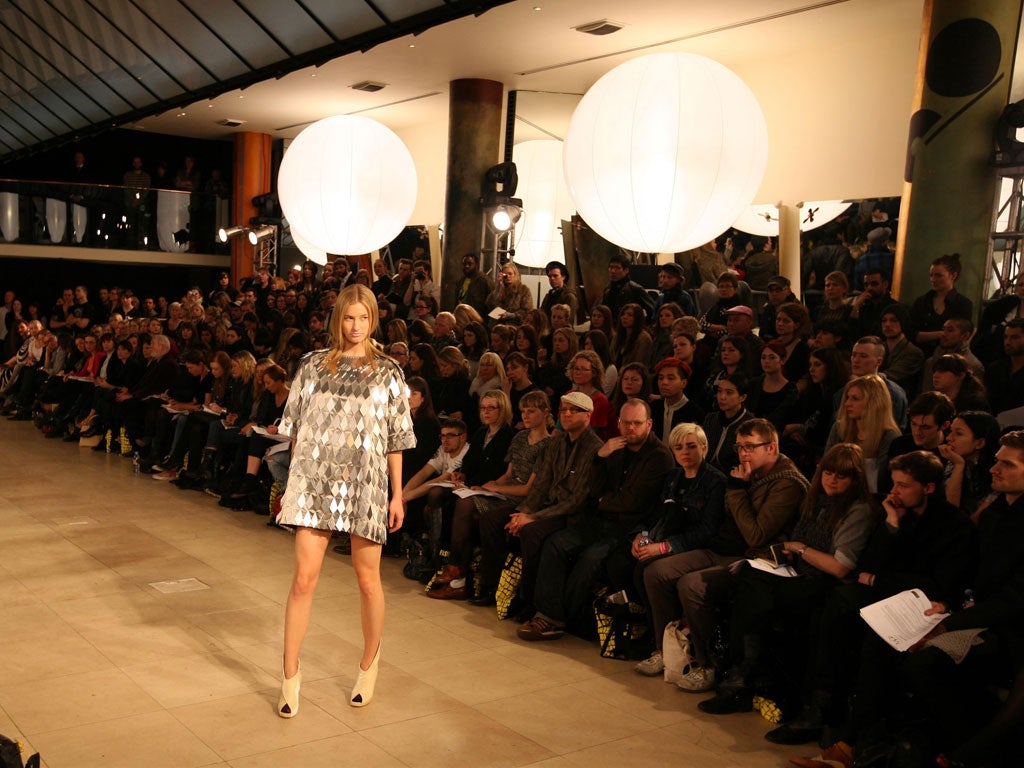How to put on a catwalk show
Debut designers learn what it takes to turn heads on the Fashion Week runway. By Harriet Walker

'A couple of seasons ago, we were re-heeling shoes round the corner of the catwalk because they kept breaking," fashion producer Charlotte Clarke tells her rapt audience of young designers. "We can help you with that, but it's not a situation any of you will want to find yourselves in."
Like a duck floating serenely but paddling frantically beneath the surface, so the shows starting today in London are slick operations for the audience front-of-house but all frenetic activity behind the scenes.
London Fashion Week, which was launched last night by Livia Firth in conjunction with the British Film Institute, will host 62 catwalk shows over the next five days, including ones from the likes of Burberry, Vivienne Westwood and milliner Philip Treacy who makes a return to the schedule this season. More than 5,000 visitors are expected to pass through the Somerset House venue.
Fashion shows are extravagant endeavours, often running up bills in the hundreds of thousands, thanks to high-spec lighting rigs, offbeat and exclusive venues, and of course, the famous faces not only on the runway but also in the front row.
"It can cost from about £5,000 for a 'showentation'," says Clarke, director of Inca productions who is working alongside the Fashion Fringe mentoring programme this season to help three fledgling designers stage their own collections. "Some of the big Paris shows cost literally millions."
For a young name showing for the first time, London Fashion Week is a daunting prospect. Fashion Fringe, established in 2003 by the fashion journalist Colin McDowell, aims to set nascent talents on the road to superstardom, offering mentoring and advice, and a slot on the official London Fashion Week schedule for the winner.
That winner will be selected on Tuesday night at a show featuring collections from this year's three finalists: Chinese-born Haizhen Wang, Teija Eilola from Finland and Londoner Vita Gottlieb. Previous winners include Erdem Moralioglu, nominated for British Designer of the Year in 2009, whose designs have been worn by the likes of Samantha Cameron and Corrie Nielsen, and whose dramatic and gothic pieces have won critical acclaim.
With only weeks before the shows kick off, the three finalists attend a meeting with Charlotte Clarke to learn how best they might realise their visions for the catwalk. Daunted but eager, they listen and take notes, to learn how to put together the biggest moment of their lives so far.
"I've never even been to a fashion show before so it's a scary and awe-inspiring concept that the first will be my own," says Gottlieb, 36, a textile designer who set up her own label earlier this year. "To get a full collection and on-schedule catwalk show together is a monumental challenge," adds Wang, 37, previously a pattern-cutter for the high street chain All Saints and Italian luxury label MaxMara, and now setting up on his own.
Clarke talks them through the parameters of the space: the main Fashion Week marquee at Somerset House. The capacity is 500; the catwalk is 30 metres long and three metres wide.
"We've got four hours on-site," Clarke says, as the designers scribble down the details. "The models will turn up three hours before the show. We'll send them down the runway every 11 or 12 seconds, and it takes 24 seconds to get to the end of it with a basic walk. If you want an intro for your music, don't make it longer than 20 seconds. Journalists see a lot of shows and they're here to look at your clothes, so don't go too far down the theatrical route."
With the London shows known increasingly for entrepreneurial spirit, as opposed to their former reputation for producing enfant terribles with great creative talent but little commercial clout, schemes such as Fashion Fringe are important for young designers who wish to go it alone.
"There has to be a concerted investment of expertise," says Colin McDowell, "because we are dealing with young creative people who are, by the very nature of what they do, vulnerable to all kinds of forces."
From the practicalities – casting models, hair and make-up tests – to the professional touches, such as providing a drinks reception and being available for interviews after the show, the candidates must learn not only how to become a fashion designer and but also how to embody their brand.
For now though, their efforts will be concentrated on the minutiae of their shows in three days' time, when the lights go up not only on their clothes but also on their futures.
Subscribe to Independent Premium to bookmark this article
Want to bookmark your favourite articles and stories to read or reference later? Start your Independent Premium subscription today.

Join our commenting forum
Join thought-provoking conversations, follow other Independent readers and see their replies